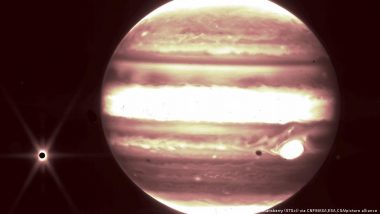On Thursday, the European Space Agency is sending up a spacecraft to explore three of Jupiter's moons. The mission will reveal more information about Jupiter's environment. Here's what we know about the planet so far.It's a big mission that will launch from the spaceport in Korou, French Guyana on Thursday. The European Space Agency (ESA) is sending up their Jupiter Icy Moons Explorer, Juice, to ― well, explore three of Jupiter's icy moons.
Doesn't sound too exciting yet? Then consider that one of the mission's goals is to characterize "these moons as both planetary objects and possible habitats," according to ESA. In other words, the mission aims to find out if life could be possible on Ganymede, Europa or Callisto, or whether life has existed on the moons in the past.
Also Read | South Korean Moon Mission: Lunar Orbiter Danuri Sends Back Its Photos of Moon's Far Side.
The Juice project is a mission of many firsts. The spacecraft, which is being sent up on an Ariane 5 rocket, will be the first to change orbits from another planet (Jupiter) to one of its moons. And it will be the first to orbit a moon other than our own.
The total costs of the mission stand at around €1.6 billion ($1.7 billion). Juice will carry several high-tech systems on board, "including the most powerful remote sensing, geophysical and in situ payloads ever flown to the outer solar system," according to ESA.
While the mission is European-led, it comes from international collaboration.NASA has contributed one of the instruments, a UV imaging spectrograph. The Japanese space agency JAXA has contributed hardware for several of the instruments on board the spacecraft, while the Israeli space agency ISA contributed hardware needed for a radio science experiment.
If things go according to plan, Juice will arrive at Jupiter in July 2031 — a marathon journey time of 8 years. It'll do 35 flybys of the three moons between July 2031 and November 2034. It will then enter Ganymede's orbit, where it's scheduled to stay and collect information until December 2035.
Here are a couple of facts to get you excited.
Jupiter, our solar system's largest planet
While the Juice mission concerns itself with three moons, Jupiter has a total of 95 moons with confirmed orbits.
Jupiter is the largest planet in our solar system, twice the mass of all the other planets combined. As NASA puts it: "If Earth were the size of a nickel [a US five-cent coin], Jupiter would be about as big as a basketball."
Jupiter's size gives it a powerful magnetic field. Part of the Juice mission is finding out how it affects the icy moons surrounding the planet.
Scientists already know the magnetic field moves gases between Jupiter's moons. Sulphur and oxygen released by volcanos on Io reach the three moons Juice will be exploring. What researchers are looking to learn from Juice is how this process works.
The moons at the center of the Juice mission
Ganymede, Callisto and Europa were discovered by Italian astronomer Galileo Galilei in 1610. They are three of the four "Galilean moons", the other being Io, and were the first objects found in our solar system that orbited a body other than the sun or Earth.
Ganymede, the Juice mission's primary target, is the only moon in our solar system that generates its own magnetic field. It's the biggest moon in our solar system, with a diameter of 5,268 kilometers (3,273 miles) and a metallic core made up of an iron-heavy liquid. Its subterranean ocean is thought to hold more water than all of Earth's oceans combined.
Callisto is Jupiter's second-largest moon. ESA scientists hope that by orbiting Callisto, Juice will gather information about the environment around Jupiter in the planet's early days. The moon is made up of equal parts rock and ice and may have a subsurface, liquid ocean located at depths greater than 100 kilometers.
Europa is slightly smaller than Earth's moon and possibly holds vast underground oceans. It is primarily made of silicate rock and has a water-ice crust. Juice scientists suspect that Europa may vent water vapor into space via plumes and geysers. Among the mission's main goals is finding out whether there are biosignatures and pockets of water on Europa ― signs of life.
The three moons are all named after Greek mythological figures. Ganymede was a hero in Greek mythology who was supposedly the most beautiful mortal on Earth and was abducted by the gods to serve as Zeus' cup bearer. Callisto was a nymph who was turned into a bear and later became the constellation Ursa Major. Europa was the mother of King Minos of Crete and lover of Zeus, who is the Greek equivalent of Roman god Jupiter.
Jupiter's challenging environment
The Juice spacecraft will work in extreme conditions. The area around Jupiter and its moons is one of the most intense radiation environments in our solar system. The temperature around the gas planet stands at a chilly -230 degrees Celsius (-382 degrees Fahrenheit), a stark difference from the scorching 250 degrees Celsius that Juice will have to withstand during its Venus flyby on the way to Jupiter.
The gravity-assisted flyby, a casual 300 million kilometer detour, will set the spacecraft on course for it's 2031 arrival at Jupiter.
The researchers behind Juice hope that the mission will be able to answer several questions on Jupiter's atmosphere, its magnetic field and how these factors interact with each other and influence the planet's moons.
The hope is that the answers to these questions will help scientists better understand fundamental physics of planetary environments and eventually figure out whether life on one of Jupiter's moons would be possible.
Edited by: Fred Schwaller
(The above story first appeared on LatestLY on Apr 12, 2023 04:10 PM IST. For more news and updates on politics, world, sports, entertainment and lifestyle, log on to our website latestly.com).













 Quickly
Quickly




















